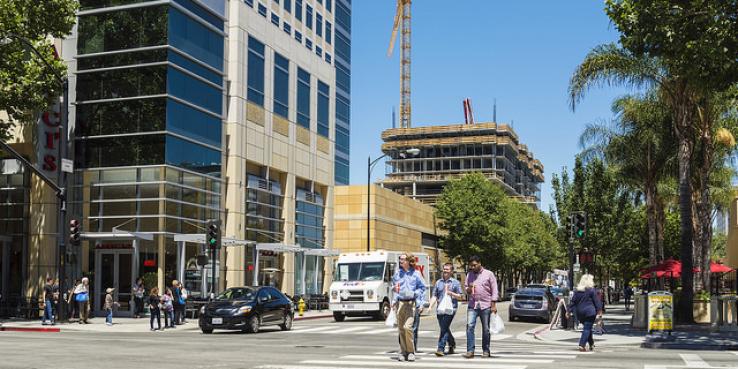Silicon Valley recently became one of the most expensive housing markets nationwide, and it has the highest rate of homelessness in the state. At the same time, funding for affordable housing in Santa Clara County has been steadily decreasing or stagnating at the federal, state and local levels.
Last month the San Jose city council approved (7-3-1) an affordable housing impact fee to be paid by developers of new market-rate rental housing, matching an existing requirement on for-sale development in certain neighborhoods of San Jose. The approved fee (starting at $17 per net rentable square foot) will apply to developments of three or more units and will increase by 2.4 percent yearly. Once it’s fully operational, the program is anticipated to generate between $20 and $30 million per year for affordable housing.
San Jose originally passed an inclusionary housing ordinance in 2010, which would have required developers of market-rate for-sale residential projects with 20 units or more to restrict 15 percent of units to households of moderate incomes. Before the ordinance was to go into effect in 2013, the California Building Industry Association challenged it in court, arguing that the city did not demonstrate a relationship between the creation of market-rate housing and need for affordable housing. The ordinance is currently under review by the California Supreme Court.
In the meantime, the dissolution of state redevelopment agencies in early 2012 severely constrained the development of affordable housing in San Jose, compounding the need for a new funding mechanism to support affordability for San Jose’s low and moderate-income households. In response to the loss of redevelopment, the San Jose City Council directed city staff to investigate a housing impact fee in late 2012.
Over the last two years, the city and Keyser Marston Associates have completed a nexus study, per state law, in order to demonstrate a legal “nexus,” or link, between the creation of new market-rate development and demand for affordable housing, thus justifying an impact fee. The city’s nexus study lays out how new residential growth leads to more demand for goods and services, which then leads to the creation of lower-wage retail and service jobs to serve those new residents. These service jobs do not pay enough for those workers to afford market-rate housing, so more affordable housing is needed. The study was narrowed to use county-level rather than state-level data and to focus on rental housing only, in order to avoid confusion with the existing inclusionary ordinance that remains in legal limbo.
To mitigate developer concerns about projects already in the works, the fee will not apply to projects that are in the official pipeline by June 2016 and complete construction by the beginning of 2020. In addition, high-rise downtown rental projects are excluded from the fee requirement until June 2021, due to their higher construction costs.
What’s next?
The fee’s opponents argue that the link between the supply of new market-rate housing and demand for affordable housing is weak at best and have threatened legal action. They argue that imposing the fee on rental residential developers places the burden on a small segment of the population when it would be more appropriate to be broadly based. The supporters of the fee agree that gathering funding from a broader base is important and should not be ignored in the longer run, but they argue that the housing impact fee is a much-needed first step that does not even go as far as it should.
Additional ideas and issues have been flagged for continued discussion, including a review of the urban village framework and exploration of a countywide tax and an impact fee charged to non-residential development. This impact fee (a “commercial linkage fee”) was not originally explored due to its conflict with the San Jose Envision 2040 Plan’s jobs-first policies and the city’s resulting focus on attracting and retaining commercial development. But it’s unclear how a new city council may stand on these policies.
One of SPUR’s major priorities is increasing the housing supply at all levels. While San Jose has long been a Bay Area leader in providing housing at both affordable and market-rate levels, the state’s closure of local redevelopment agencies has stood in the way of growing that effort. While we ideally recommend a broad-based funding source for affordable housing, a housing impact fee set at the right level, and with the right implementation timing, could provide a key opportunity to help build more affordable housing in San Jose.
Read our blog post on the 2010 inclusionary housing ordinance >>
Check out the city’s updates on the housing impact fee >>
